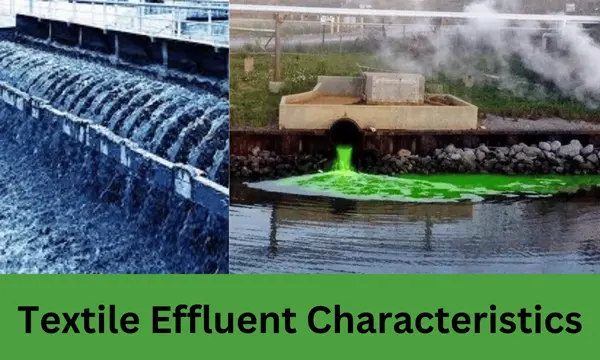Textile Effluent Characteristics and Methods of Textile Effluent Treatment in The Textile Industry
Textile Effluent is a polluting element emitted from the textile factory. These Effluents are causes of air population because of many chemicals presence there. Effluent characteristics of textiles have two parameters. One is a physical parameter and the other is a chemical parameter. In this article, we explain Textile Effluent Characteristics and Methods of Textile Effluent Treatment in The Textile Industry.

Physical Parameters of Effluent characteristics in Textile Industry
- Color: The color of water could be a physical indicator of the purity of surface and ground waters. Basically soluble and insoluble substances are responsible for it. Pure natural waters area typically colorless or azure‑blue in thick layers. Basically tintometer in PCU (Platinum metal unit) as a unit, determines the color.
- Odor: The odor of water is a volatile substance gift in water that area unit perceived by the sense of smell, significantly living microscopic organism or decaying vegetation together with protoctist, actinomycetes, bacteria, fungi and weeds. Waste products and industrial wastes additionally contribute taste and odor to receiving waters.
- Temperature: Temperature is one of the foremost necessary parameters for aquatic settings as a result of the majority the physical, chemical and biological properties area unit ruled by it.
- Taste: The style influenced by substances introduced into water naturally or by pollution. The influence of the water test depends on iron, manganese, magnesium, calcium, zinc, copper, chlorides, sulfates, gas carbonates, dioxide, etc.
- Total Dissolved Solids (TDS): Total dissolved solids contents of water and waste water is outlined because the residue left upon evaporation at 103°C to 105°C. It aggregates the quantity of the complete floating, suspended, settable, and dissolved solids gift within the water sample.
Chemical parameters of Effluent characteristics in Textile Industry
- pH: pH scale could be a term universally to specific the intensity of the acidic or alkalescent condition of resolution. It’s a live of cation concentration or a lot of exactly the cation activity. It’s outlined because of the ” exponent (base 10) of the reciprocal of the cation concentration”.
- Electrical conduction (EC): Electrical conduction could be a live of water capability to convey electrical phenomena. Electrical conduction of water and waste area unit directly proportional to its dissolved matter content (dissolved gases additionally contribute). The unit of conduction is µS/cm.
- Hardness: Hardness is the capability of water to reduce and destroy the lather of soap. The hardness is owing to power cations like Ca+2, Sr+2, etc. Higher cations additionally contribute hardness to a lesser degree however mono‑valent cations ne’er turn out hardness.
- Alkalinity: pH is associate with anionic development. it’s the quantitative capability of associate binary compound media to react with gas ions. The prevalence of cation in natural water is extremely rare unless artificial contamination has occurred.
- Dissolved chemical element (DO): A dissolved chemical element shows the power of the stream to purify itself through the organic chemistry method. Chemical element is dissolved in most waters in varied concentrations. The solubility of chemical elements depends on temperature, pressure and salinity of water. it’s essential to the lifetime of fish and different aquatic organisms.
- Bio‑chemical chemical element Demand (BOD): Bio‑chemical chemical element demand tests show the quantity of molecular chemical elements needed by microorganism to scale back the carbonic materials and transformation of organic matter below aerobic conditions. It takes a look at nice worth within the analysis of waste product, industrial effluents and grossly contaminated waters.
It is a bioassay procedure that measures the chemical element consumed by living organisms, whereas utilizing the organic matter.
The determination of DO of a sample before and once 5 days incubation at 20°C is that the basic of flesh determination. - Chemical element Demand (COD): The yankee Society for Testing and Materials (ASTM) defines chemical chemical element demand because the quantity of chemical element, expressed in mg/l consumed below specific conditions within the oxidisation of organic and reactive inorganic matter, corrected for the influence of chlorides.
COD takes a look at shows the chemical element equivalent of the organic matter which will be change by employing a robust oxidizing agents e.g. salt in acidic resolution, at elevated temperature, for 2 and [*fr1] hour.
It has to be classified that COD isn’t a live of the carbon content. It indicates the quantity of chemical elements needed to oxidize the carbonic matter.
Methods of textile effluent Treatment | Textile Effluent Treatment Methods
Methods of textile effluent treatment vary in terms of using chemicals but methods are same. Before knowing the methods of textile effluent treatment, we must know about the Textile effluent. Effluent treatment plants area unit the foremost wide accepted approaches towards achieving environmental safety. But, sadly, no single treatment methodology is appropriate or universally adoptable for any reasonably effluent treatment. The treatment of waste streams is finished by varied strategies, that embrace physical, chemical and biological treatment looking on pollution load. The treatment processes is also categorized into preliminary, primary, secondary and tertiary treatment method.
Methods of textile effluent treatment
The methods of treatment within which the appliance of physical forces predominate area units are called unit operations. Methods of treatment within which the removal of contaminants is led to by chemical or biological reactions area unit called unit processes. At present time, unit operations and processes area unit sorted along to produce varied levels of treatment. We call them preliminary, primary, advanced primary, secondary, and advanced or tertiary treatment.
